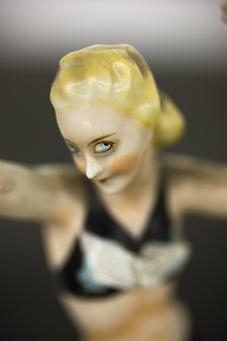Alicja Kwade: Peep-Hole
With Six Ways to Sunday Peep-Hole explores the programmes of six international museums with leading contemporary art programmes. The collaboration between the institutions involved aims to establish Peep-Hole and Milan as a production centre for the convergence of diverse approaches and methods, with a view to forging a network of international connections and exchanges over time.
The museum invited to open the series is Museion - Museum of Modern and Contemporary Art Bolzano - one of Italy’s most international institutions, and with Peep-Hole is pleased to present the first solo exhibition in Italy by Polish-born/Berlin-based artist Alicja Kwade.
With the project Broken Away from Common Standpoints Alicja Kwade transforms Peep-Hole venue into a fairy-tale, festive landscape. Dozens of ballerina figurines collected by the artist over the years fill the entire exhibition space with their seductive forms. All from different periods and places, in their diversity and uniqueness the figurines of Weisses Gold (animal metaphysicum) (2010), all strike a similar pose, with their arms raised above their heads. They also have something else in common apart from their poses: they all look in the same direction. The artist has altered the face of each figurine, redesigning them to make them all look upwards. The antique, slightly kitsch appeal of the figurines combines with the erotic power of the pose and the almost religious ecstasy it contains.
The spectacle of these dancing figures is reflected in a series of mirrors that assimilate and reproduce their exuberance and vitality. In Vom zukünftigem Hintergrund unter anderer Bedingung betrachtend (2010), the artist visualizes a mirror sliding down a wall to the floor in seven different stages, almost “melting” from its vertical position down onto the floor. The eccentric, baroque feel of the colorful ballerinas interacts dialectically with the abstraction and formal rigor of the mirrors, and while the former are fixed, as if frozen in a moment of euphoria, in the mirrors this movement flows once more, going forward or back in time, enabling us to interpret the chronology of an event one way or in the opposite direction.
Alicja Kwade was born in Katowice (Poland) in 1979. She lives and works in Berlin. Her main solo exhibitions include: Grenzfälle fundamentaler Theorien, Johann König, Berlin (2009); Von Explosionen zu Ikonen (Piepenbrock Preis für Skulptur) Hamburger Bahnhof, Museum für Gegenwart, Berlin (2008). Recent group shows include: Black Hole, Centro Cultural Andratx, Mallorca; Pragmatismus & Romantismus, Fondation Ricard, Paris (2009); The Krautcho Club/In and out of place, Projectspace 176, London; When a watch is seen from the side it no longer tells the time, Galerie Johann König, Berlin (2008); LichtWerke - Kunst und Licht seit den 1960er Jahren, Museum Moderner Kunst Stiftung Ludwig - MUMOK, Vienna (2006).

Recommended for you
With Six Ways to Sunday Peep-Hole explores the programmes of six international museums with leading contemporary art programmes. The collaboration between the institutions involved aims to establish Peep-Hole and Milan as a production centre for the convergence of diverse approaches and methods, with a view to forging a network of international connections and exchanges over time.
The museum invited to open the series is Museion - Museum of Modern and Contemporary Art Bolzano - one of Italy’s most international institutions, and with Peep-Hole is pleased to present the first solo exhibition in Italy by Polish-born/Berlin-based artist Alicja Kwade.
With the project Broken Away from Common Standpoints Alicja Kwade transforms Peep-Hole venue into a fairy-tale, festive landscape. Dozens of ballerina figurines collected by the artist over the years fill the entire exhibition space with their seductive forms. All from different periods and places, in their diversity and uniqueness the figurines of Weisses Gold (animal metaphysicum) (2010), all strike a similar pose, with their arms raised above their heads. They also have something else in common apart from their poses: they all look in the same direction. The artist has altered the face of each figurine, redesigning them to make them all look upwards. The antique, slightly kitsch appeal of the figurines combines with the erotic power of the pose and the almost religious ecstasy it contains.
The spectacle of these dancing figures is reflected in a series of mirrors that assimilate and reproduce their exuberance and vitality. In Vom zukünftigem Hintergrund unter anderer Bedingung betrachtend (2010), the artist visualizes a mirror sliding down a wall to the floor in seven different stages, almost “melting” from its vertical position down onto the floor. The eccentric, baroque feel of the colorful ballerinas interacts dialectically with the abstraction and formal rigor of the mirrors, and while the former are fixed, as if frozen in a moment of euphoria, in the mirrors this movement flows once more, going forward or back in time, enabling us to interpret the chronology of an event one way or in the opposite direction.
Alicja Kwade was born in Katowice (Poland) in 1979. She lives and works in Berlin. Her main solo exhibitions include: Grenzfälle fundamentaler Theorien, Johann König, Berlin (2009); Von Explosionen zu Ikonen (Piepenbrock Preis für Skulptur) Hamburger Bahnhof, Museum für Gegenwart, Berlin (2008). Recent group shows include: Black Hole, Centro Cultural Andratx, Mallorca; Pragmatismus & Romantismus, Fondation Ricard, Paris (2009); The Krautcho Club/In and out of place, Projectspace 176, London; When a watch is seen from the side it no longer tells the time, Galerie Johann König, Berlin (2008); LichtWerke - Kunst und Licht seit den 1960er Jahren, Museum Moderner Kunst Stiftung Ludwig - MUMOK, Vienna (2006).
Artists on show
Contact details


 ARTISTS
ARTISTS











